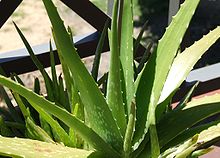Aloe vera

Aloe vera (/ˈæloʊiː/ or /ˈæloʊ/) is a succulent plant species of the genus Aloe.[3] An evergreen perennial, it originates from the Arabian Peninsula, but grows wild in tropical, semi-tropical, and arid climates around the world.[3] It is cultivated for agricultural and medicinal uses.[3] The species is also used for decorative purposes and grows successfully indoors as a potted plant.[4]
It is found in many consumer products including beverages, skin lotion, cosmetics, ointments or in the form of gel for minor burns and sunburns. There is little clinical evidence for the effectiveness or safety of Aloe vera extract as a cosmetic or medicine.[5][6]
Aloe vera is a stemless or very short-stemmed plant growing to 60–100 centimetres (24–39 inches) tall, spreading by offsets.[3] The leaves are thick and fleshy, green to grey-green, with some varieties showing white flecks on their upper and lower stem surfaces.[7] The margin of the leaf is serrated and has small white teeth. The flowers are produced in summer on a spike up to 90 cm (35 in) tall, each flower being pendulous, with a yellow tubular corolla 2–3 cm (3⁄4–1 1⁄4 in) long.[7][8] Like other Aloe species, Aloe vera forms arbuscular mycorrhiza, a symbiosis that allows the plant better access to mineral nutrients in soil.[9]
Aloe vera leaves contain phytochemicals under study for possible bioactivity, such as acetylated mannans, polymannans, anthraquinone C-glycosides, anthrones, and other anthraquinones, such as emodin and various lectins.[10][11]
